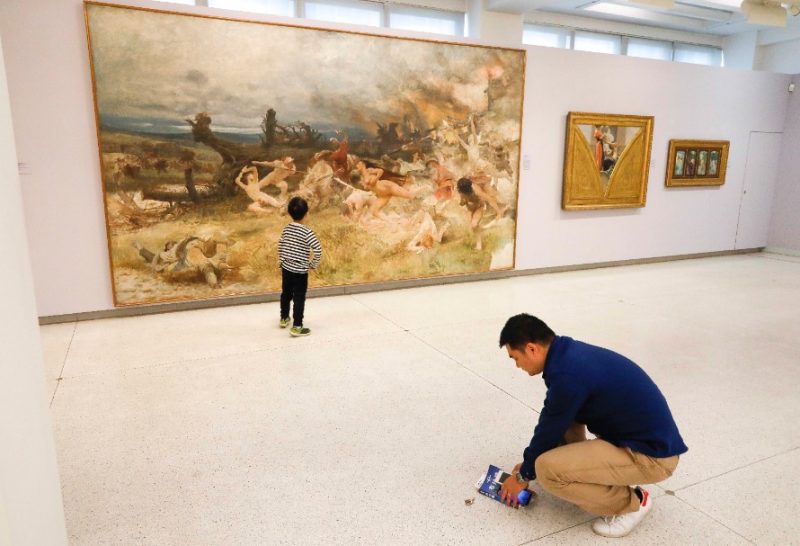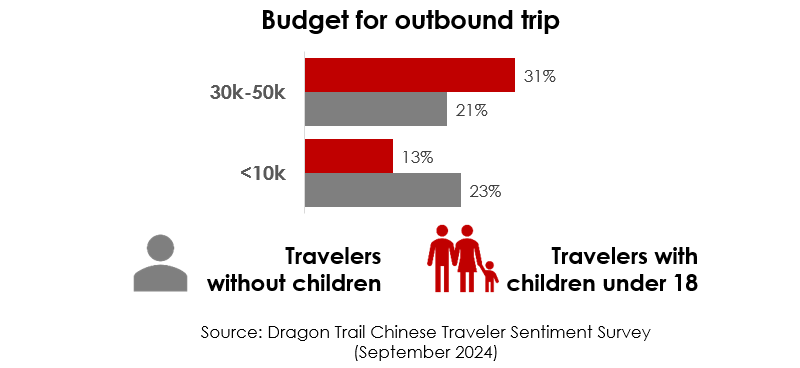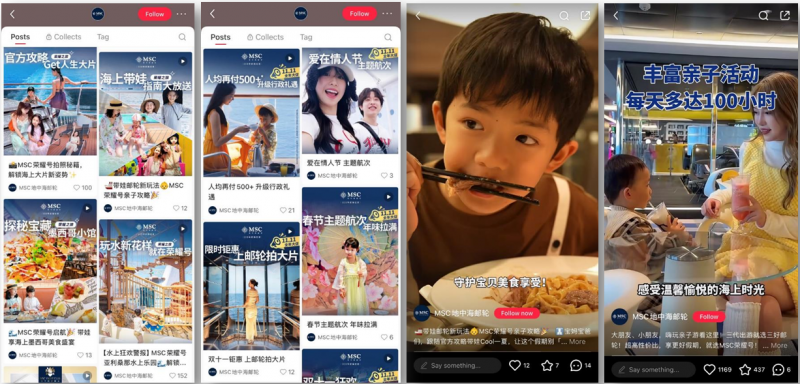
A Chinese family in Prague, October 2019. Photo by Gene Parulis
There are around 250 million children in China under the age of 16, and family travel is a significant and high-value market segment, with families spending up to twice as much as travelers without children. Based on information shared during Dragon Trail’s November 2024 webinar on Chinese family travel, here are seven essential points to understand about Chinese family travelers, what they’re looking for from outbound travel destinations and products, and how you can best reach them through digital marketing.
1. Summer is the peak season for family travel, but other holidays are important too
Chinese families tend to travel at very specific times of year, and this is influenced by the school and national public holiday schedule. The longest vacation period for Chinese schoolchildren is in the summer, with six to eight weeks starting from early to mid-July, and ending on the first Monday in September. During this time, family travelers account for more than half of the entire Chinese travel market, as well as more than half of outbound travel bookings.
Another peak travel period is in winter, where children get four weeks off of school, starting one week before Chinese New Year. Parents also have time off then, with one of the longest public holiday periods of the year. Because there are so many other Chinese traveling outbound at this time, family travelers don’t dominate the market quite as much as they do in the summer, but still make up just under half the market, which is very significant. This is a peak period for long-haul family trips.
The October National Day holiday, when parents get seven or eight days off for public holidays, is another period suitable for long-haul travel. In 2024, Ctrip reported that family travelers accounted for 37% of the outbound market during October’s Golden Week, up from 34% the year before.
And in May, parents and children get a five-day break for Labor Day – the short length of this holiday makes it most suitable for short-haul trips within Asia.
Click here to view China’s 2025 public holiday calendar
2. Travel must have educational value
If there’s one thing that sets Chinese family travel apart from other source markets and is truly essential to understand, it’s the emphasis on the educational value of travel.
“It’s the most important for Chinese family travel, because in the Chinese family, parents pay a lot of attention to education. If they do overseas travel, they really like their children to learn something during the trip. The education program is the key point in your product, even if the children are only 3 years old,” advises Liu Hongshi, GM International Culture and Educational Exchange Department, CTG Travel, and member of the China Family Travel Alliance.
Chinese parents see travel as an important opportunity for the education and development of their children, and this can take many forms, including everything from taking language classes, skiing lessons, participating in a nature conservation program, visiting a famous university, or even trying exotic food.
When it comes to visiting universities, Chinese families will want to go to the most prestigious and well known – for example: Harvard, Stanford, Yale, and MIT in the US; or Oxford and Cambridge in the UK.
Visits to cultural institutions such as museums should ideally be structured and in-depth, and families will expect to stay around two to three hours touring a museum, says Liu.

Museum visits are important for Chinese parents traveling with their young children
3. Chinese parents are looking for travel information online
These days, Chinese parents look for and share parenting information online, and this includes travel information. Dragon Trail’s September 2024 sentiment survey found that travelers with children were more likely to search for destination information on both Ctrip and Mafengwo, indicating that they might be researching more thoroughly and preparing even more for their outbound trips.

Social media platforms are also relevant. On WeChat, travel brands are most likely to publish information about traveling with children in the summer time, starting with International Children’s Day on 1 June. Apart from publishing content on your WeChat official account, we would also recommend working with KOLs on WeChat for family-focused marketing. There are some very popular family travel accounts on WeChat who not only publish information and promote deals through subscription accounts, but also run large chat groups for parents where they can share information.
Xiaohongshu (aka Little Red Book aka RED) is a particularly good fit for reaching Chinese family travelers for a couple of reasons. First, it’s dominated by women, and mothers tend to be the decision makers for family travel. Xiaohongshu is also a great fit for the family market because it’s used as a search engine, and it’s where parents will be looking up information to plan their trips, asking other users for advice, and discussing questions about traveling with kids in the comments section of posts.
For example, when you type “take your kids…” into Xiaohongshu’s search bar, the suggested queries start with “which countries are good for traveling abroad with kids?” with 3 million notes. Other suggested topics include recommended cities for traveling with kids, traveling with kids in Japan, flying with kids, hiking with kids, going to Disneyland with kids, and going to Hong Kong with kids. There are all sorts of extremely detailed guides and suggestions on traveling with children, as well as lots of family travel KOLs and KOCs.
Dragon Trail is experienced in running successful influencer campaigns for the family travel market on both WeChat and Xiaohongshu. Please contact us to discuss how we can help you with campaigns and content marketing.
4. Demands change with children’s ages
The way Chinese families travel will depend significantly on the children’s ages. Liu Hongshi divides up the market into three key segments by children’s ages: 3-6, 7-12, and 13-18.
Although education and learning experiences are important at any age, the emphasis for families with children aged 3-6 is more on fun and relaxation. Overseas trips at this age are also slightly shorter – Liu says parents won’t go abroad for more than 7-10 days with very young children – and may be closer to home. Theme parks, cruises, beach resorts, and Club Med experiences are all well suited to this age group.
From the age of 7, families will travel longer and further, with more intensive itineraries. At this point, primary school children have long holidays and time for overseas trips with their parents, and trips may last 7-13 days. “It’s very important for children to learn something and develop in foreign countries, especially those with abundant culture, history, and nature,” says Liu. This is the time for children to start doing more cultural activities on trips, including museum tours. From around the age of 9, families will also be interested in more nature experiences that emphasize animal conservation – for example, visiting elephant sanctuaries in Thailand or national parks in Kenya.
From the age of 13, families may consider sending their children on “study tours” with overseas academic coursework or sports training. When traveling together, they’ll be even more inclined to visit universities and seek out in-depth, intensive education experiences such as expert tours and lectures at museums and historical sites.
5. Parents spend more for comfort and assurance
One of the reasons the family travel market is such an attractive segment is that families spend more. This is partly just because they’re traveling with more people, and paying for their children’s travel, but it’s also related to the choices they make to ensure that travel is more comfortable, such as booking higher-end hotels or private tour products.
Dragon Trail Research found that travelers with children under the age of 18 were much less likely than travelers without children to be traveling on a shoestring budget of RMB10k or less, and much more likely to be budgeting RMB30-50k for their next trip, equivalent to around US$4-7k USD.

During 2024’s National Day holiday, Ctrip reported that family travelers spent twice as much as the average. And a 2023 report by Ctrip and Volvo showed that while family travelers accounted for 28% of the total market in 2023, they made 38% of high-end hotel bookings and 55% of the bookings for private group travel products, with huge year-on-year growth for both.
When it comes to accommodation, Liu Hongshi says Chinese families are looking for “luxury, high-end, five star, good location, international brand, good service, kid-friendly hotels.” Hotels like these are considered the safest, healthiest, and most convenient. She also notes that families will want to book hotels that have swimming pools. Rooms should have two large (1.3-1.35 meters wide) beds, with the expectation that two children can share one bed.
6. Cruise: A new family tradition
Cruises are a particularly suitable travel product for Chinese families traveling with three generations together, and they are becoming a new Chinese family tradition for the Lunar New Year, says Liu Hongshi. “It’s the best place for families to all get together with grandparents and young kids. Young parents will be relaxed and have a rest,” she says. As for accommodation, the cruise should offer five-star facilities and high quality food.

MSC Cruises has made family travel one of its main content pillars on Xiaohongshu
7. Food is part of the family travel experience
What considerations need to be made around food for Chinese families? On one hand, it’s best to have easy access to Chinese restaurants and Chinese food, to ensure that travelers have the comfort of familiar tastes, and this is especially true for multi-generation family groups traveling with grandparents. On the other hand, says Liu, “We want to experience local delicacies. We want our children to learn to make local food – this is a very interesting experience.” She gives examples of pizza-making classes in Italy, and tours of local markets where families can see and learn about local life.
Young Chinese are also likely to have grown up with international cuisines and be more accustomed to regularly eating western food. As with cooking classes, foreign food can also be framed as a learning opportunity, when children will be exposed to new flavors and new cultures at the dinner table.
Information in this article comes from Dragon Trail’s November 2024 webinar on Chinese family travel with guest speaker Liu Hongshi from CTG. Click here to watch a recording of the webinar, and contact us to request the presentation slides and discuss how Dragon Trail can help you with marketing initiatives to attract Chinese family travelers.
Sign up for our free newsletter to keep up to date on our latest news
We do not share your details with any third parties. View our privacy policy.
This website or its third party tools use cookies, which are necessary to its functioning and required to achieve the purposes illustrated in the cookie policy. If you want to know more or withdraw your consent to all or some of the cookies, please refer to the cookie policy. By closing this banner, scrolling this page, clicking a link or continuing to browse otherwise, you agree to the use of cookies.